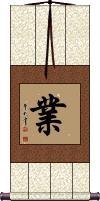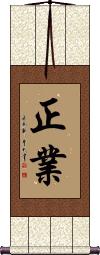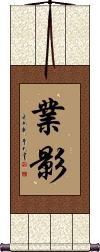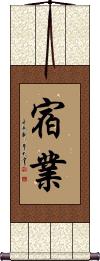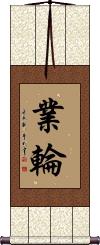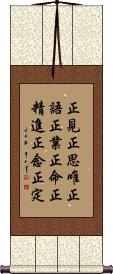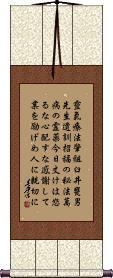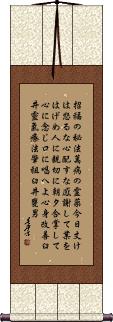Many custom options...
And formats...

業 in Chinese / Japanese...
Buy an 業 calligraphy wall scroll here!
Personalize your custom “業” project by clicking the button next to your favorite “業” title below...
1. Karma
2. 4. Right Action / Perfect Conduct
3. Shadow of Karma / Dogged by Karma
4. Karma
7. Live in Peace and Contentment
8. All Tenets of the Noble Eightfold Path
9. The Five Principles of Reiki
Karma
Single character for Buddhist Karma
This is the simplest way to express the idea of Karma. This is the Buddhist concept of actions committed in a former life affecting the present and future.
Out of the context of Buddhism, this Karma character means one's profession in life, trade, occupation, business, study, or career.
The Karma definition applies to both Chinese and Japanese for this character. This also works as Korean Hanja as Karma; although the meaning can vary depending on context (my Korean dictionary gives the definition of profession/occupation).
4. Right Action / Perfect Conduct
Samyak Karmanta / Samma Kammanta
正業 is one of the Noble Eightfold Paths of Buddhism. Right Action, along with Right Speech and Right Living, constitute the path to Virtue.
The five precepts of Right Action are...
1. Refrain from destroying living beings (no murder or any form of taking a life).
2. Refrain from stealing.
3. Refrain from sexual misconduct (adultery, rape, etc.).
4. Refrain from false speech (lying or trickery).
5. Refrain from intoxicants that lead to heedlessness (no drugs or alcohol).
This concept can be summarized as “Avoidance of actions that conflict with moral discipline.”
Note: In Japanese, when read by a non-Buddhist, this will mean “the right job/vocation.”
This term is exclusively used by devout Buddhists. It is not a common term, and is remains an unknown concept to most Japanese and Chinese people.
Shadow of Karma / Dogged by Karma
Karma (of your past lives)
宿業 is the Buddhist concept of Past Karma. Simply put, it's the sum of all the good and bad from all previous lives (perhaps earlier in your current life). This term is not commonly used outside of the Buddhist faith (you'll have a tough time finding a non-Buddhist Asian person that knows this word).
Other ways to translate this are “The karma of previous existence,” “The karma remaining from prior existences,” or simply “Former karma.”
Wheel of Karma
Industrious / Hard Working
Live in Peace and Contentment
安居樂業 is the Chinese, Japanese Kanji, and old Korean Hanja proverb for “living in peace and working happily,” or “to live in peace and be content with one's occupation.”
All Tenets of the Noble Eightfold Path
These are the eight tenets of the Buddhist Noble Eightfold Path written altogether.
Here's this list of tenets in English:
1. Right View / Right Understanding / Right Perspective / Perfect View
2. Right Resolve / Right Thought / Right Intention / Perfect Resolve
3. Right Speech / Right Talk / Perfect Speech
4. Right Action / Perfect Conduct
5. Right Living / Right Livelihood / Perfect Livelihood
6. Right Effort / Right Endeavor / Perfect Effort
7. Right Mindfulness / Right Memory / Perfect Mindfulness
8. Right Concentration / Perfect Concentration
The Five Principles of Reiki
Reiki Gokai
These are the five principles of Reiki.
They translate into English as...
At least for today:
Do not be angry,
Do not worry,
Be grateful,
Work with diligence,
Be kind to people.
Note: Because this selection contains some special Japanese Hiragana characters, it should be written by a Japanese calligrapher.
Tom Clan Generational Poem
爾昌友延嗣捷開文裔光宗傳世澤遠晉本立道隆積善家國重學業廣成芳 is the Tom Clan Generational Poem.
If you are interested in this poem, you probably already know the meaning, so for now we'll forgo including a translation.
Reiki Precepts by Usui Mikao (Alternate)
Alternate Version
靈氣療法肇祖臼井甕男先生遺訓招福の秘法萬病の霊薬今日丈けは心配すな感謝して業を励げめ人に親切に is an alternate version of the precepts or tenets of Reiki by Usui Mikao.
It is impossible to be sure which version or versions were actually written by Usui Mikao. This is the less common of the three versions that you might see in the wild.
Here is a breakdown of the characters and a rough translation:
靈氣 療法 肇祖 臼井甕男。
Reiki therapy founder Mikao Usui
先生 遺訓。
Teacher's testament
招福の秘法, 萬病の霊薬。
Invite blessings of [the] secret method, 10,000 illnesses of spiritual medicine.
今日丈けは: 怒るな, 心配すな, 感謝して, 業をはげめ, 人に親切に。
At least for today: Do not be angry, do not worry, be grateful, work with diligence, [and] be kind to people.
Note: Because this selection contains some special Japanese Hiragana characters, it should be written by a Japanese calligrapher.
Reiki Precepts by Usui Mikao
These are the precepts of Reiki that are attributed to Usui Mikao.
Here is a breakdown of the characters and a rough translation:
招福の秘法, 萬病の霊薬。
Invite blessings of [the] secret method, 10,000 illnesses of spiritual medicine.
今日丈けは: 怒るな, 心配すな, 感謝して, 業をはげめ, 人に親切に。
At least for today: Do not be angry, do not worry, be grateful, work with diligence, and be kind to people.
朝夕合掌して, 心に念じ, 口に唱へよ, 心身改善。
Morning [and] evening perform gassho (join hands), [with your] heart/mind in silent prayer, [with your] mouth chant, [thusly] mind [and] body [will] reform/improve.
臼井靈氣療法! -肇祖, 臼井甕男。
Usui Reiki Ryōhō! -Founder, Usui Mikao.
The middle portion of this is often titled, “The Five Principles of Reiki” and makes a nice calligraphy selection by itself. The Japanese text presented here can be considered the more verbose version.
Note: Because this selection contains some special Japanese Hiragana characters, it should be written by a Japanese calligrapher.
Not the results for 業 that you were looking for?
Below are some entries from our dictionary that may match your 業 search...
| Characters If shown, 2nd row is Simp. Chinese |
Pronunciation Romanization |
Simple Dictionary Definition |
業 业 see styles |
yè ye4 yeh hajime はじめ |
More info & calligraphy: Karmadeed; act; work; performance; (personal name) Hajime karman, karma, "action, work, deed"; "moral duty"; "product, result, effect." M.W. The doctrine of the act; deeds and their effects on the character, especially in their relation to succeeding forms of transmigration. The 三業 are thought, word, and deed, each as good, bad, or indifferent. Karma from former lives is 宿業, from present conduct 現業. Karma is moral action that causes future retribution, and either good or evil transmigration. It is also that moral kernel in which each being survives death for further rebirth or metempsychosis. There are categories of 2, 3, 4, 6, and 10; the 六業 are rebirth in the hells, or as animals, hungry ghosts, men, devas, or asuras: v. 六趣. |
宿業 宿业 see styles |
sù yè su4 ye4 su yeh shukugou / shukugo しゅくごう |
More info & calligraphy: Karma (of your past lives)Former karma, the karma of previous existence. |
業影 业影 see styles |
yè yǐng ye4 ying3 yeh ying gōyō |
More info & calligraphy: Shadow of Karma / Dogged by Karma |
業輪 业轮 see styles |
yè lún ye4 lun2 yeh lun gōrin |
More info & calligraphy: Wheel of Karma |
正業 正业 see styles |
zhèng yè zheng4 ye4 cheng yeh seigyou / segyo せいぎょう |
More info & calligraphy: 4. Right Action / Perfect Conductlegitimate occupation; honest business samyakkarmānta, right action, purity of body, avoiding all wrong, the fourth of the 八正道; 'right action, abstaining from taking life, or what is not given, or from carnal indulgence. ' Keith. |
安居樂業 安居乐业 see styles |
ān jū lè yè an1 ju1 le4 ye4 an chü le yeh |
More info & calligraphy: Live in Peace and Contentment |
愛崗敬業 爱岗敬业 see styles |
ài gǎng jìng yè ai4 gang3 jing4 ye4 ai kang ching yeh |
More info & calligraphy: Industrious / Hard Working |
一業 一业 see styles |
yī yè yi1 ye4 i yeh ichi gō |
A karma; a 業困 karma-cause, causative of the next form of existence. |
三業 三业 see styles |
sān yè san1 ye4 san yeh sangou / sango さんごう |
{Buddh} (See 身口意) three activities (action, speech and thought) trividha-dvāra. The three conditions, inheritances, or karma, of which there are several groups. (1) Deed, word, thought, 身, 口, 意. (2) (a) Present-1ife happy karma; (6) present-life unhappy karma; (c) 不動 karma of an imperturbable nature. (3) (a) Good; (b) evil; (c) neutral karma. (4) (a) 漏業 Karma of ordinary rebirth; (6) 無漏業 karma of Hīnayāna nirvana; (c) 非漏非無漏 karma of neither, independent of both, Mahāyāna nirvana. (5) (a) Present deeds and their consequences in this life; (b) present deeds and their next life consequences; (c) present deeds and consequences after the next life, There are other groups of three. |
上業 上业 see styles |
shàng yè shang4 ye4 shang yeh jōgō |
an excellent practice |
丕業 see styles |
higyou / higyo ひぎょう |
great deed; great undertaking |
主業 主业 see styles |
zhǔ yè zhu3 ye4 chu yeh shugyou / shugyo しゅぎょう |
main business one's main profession |
九業 九业 see styles |
jiǔ yè jiu3 ye4 chiu yeh kugō |
The nine kinds of karma, i.e. the desire realm and the form realm each has conduct that causes karma, does not cause karma, or is neutral, making 6; in the formless realm there are non-causative deeds, neutrality, and immortality, making 9; 成實論 8. |
乳業 乳业 see styles |
rǔ yè ru3 ye4 ju yeh nyuugyou / nyugyo にゅうぎょう |
dairy industry; dairy farming dairy industry |
事業 事业 see styles |
shì yè shi4 ye4 shih yeh jigyou / jigyo じぎょう |
undertaking; project; activity; (charitable, political or revolutionary) cause; publicly funded institution, enterprise or foundation; career; occupation; CL:個|个[ge4] (1) business; enterprise; venture; (commercial) activity; (business) operation; industry; (2) (social) project; undertaking; enterprise; work; activity; program; service action |
二業 二业 see styles |
èr yè er4 ye4 erh yeh nigyou / nigyo にぎょう |
(archaism) restaurants and geisha establishments Two classes of karma. (1) (a) 引業 leads to the 總報, i.e. the award as to the species into which one is to be born, e.g. men, gods, etc.; (6) 滿業 is the 別報 or fulfillment in detail, i.e. the kind or quality of being e.g. clever or stupid, happy or unhappy, etc. (2) (a) 善業 and (b) 惡業 Good and evil karma, resulting in happiness or misery. (3) (a) 助業 Aids to the karma of being reborn in Amitābha's Pure—land e. g. offerings, chantings, etc.; (b) 正業 thought and invocation of Amitābha with undivided mind, as the direct method. |
五業 五业 see styles |
wǔ yè wu3 ye4 wu yeh gogō |
The five kinds of karma: of which the groups are numerous and differ. |
仕業 see styles |
shiwaza しわざ |
deed (esp. negative); act; action; one's doing |
企業 企业 see styles |
qǐ yè qi3 ye4 ch`i yeh chi yeh kigyou / kigyo きぎょう |
company; firm; enterprise; corporation; CL:家[jia1] enterprise; business; company; corporation |
休業 see styles |
kyuugyou / kyugyo きゅうぎょう |
(n,vs,vi) suspension of business; temporary closure (of a store, school, etc.); shutdown; holiday |
余業 see styles |
yogyou / yogyo よぎょう |
side line; avocation |
作業 作业 see styles |
zuò yè zuo4 ye4 tso yeh sagyou / sagyo さぎょう |
school assignment; homework; work; task; operation; CL:個|个[ge4]; to operate (n,vs,vi) work; operation; task Karma produced, i.e. by the action of body, words, and thought, which educe the kernel of the next rebirth. |
依業 依业 see styles |
yī yè yi1 ye4 i yeh egō |
karma-basis |
俗業 俗业 see styles |
sú yè su2 ye4 su yeh zokugō |
worldly activities or business |
保業 see styles |
yasunobu やすのぶ |
(given name) Yasunobu |
修業 修业 see styles |
xiū yè xiu1 ye4 hsiu yeh shiyugyou / shiyugyo しゆぎょう |
to study at school (n,vs,vt,vi) pursuit of knowledge; studying; learning; training; completing a course; (surname) Shiyugyou practice; cultivation |
偉業 伟业 see styles |
wěi yè wei3 ye4 wei yeh igyou / igyo いぎょう |
exploit; great undertaking great achievement; great feat; great work; great undertaking |
停業 停业 see styles |
tíng yè ting2 ye4 t`ing yeh ting yeh |
to cease trading (temporarily or permanently); to close down |
先業 先业 see styles |
xiān yè xian1 ye4 hsien yeh sengō |
Karma from a previous life. |
克業 see styles |
katsunari かつなり |
(male given name) Katsunari |
Click here for more 業 results from our dictionary
The following table may be helpful for those studying Chinese or Japanese...
| Title | Characters | Romaji (Romanized Japanese) | Various forms of Romanized Chinese | |
| Karma | 業 业 | gou / go | yè / ye4 / ye | yeh |
| 4. Right Action Perfect Conduct | 正業 正业 | sei gyou / seigyou / sei gyo | zhèng yè / zheng4 ye4 / zheng ye / zhengye | cheng yeh / chengyeh |
| Shadow of Karma Dogged by Karma | 業影 业影 | gou you / gouyou / go yo | yè yǐng / ye4 ying3 / ye ying / yeying | yeh ying / yehying |
| Karma (of your past lives) | 宿業 宿业 | shukugou / shukugo | sù yè / su4 ye4 / su ye / suye | su yeh / suyeh |
| Wheel of Karma | 業輪 业轮 | gōrin | yè lún / ye4 lun2 / ye lun / yelun | yeh lun / yehlun |
| Industrious Hard Working | 愛崗敬業 爱岗敬业 | ài gǎng jìng yè ai4 gang3 jing4 ye4 ai gang jing ye aigangjingye | ai kang ching yeh aikangchingyeh |
|
| Live in Peace and Contentment | 安居樂業 安居乐业 | an kyo raku gyou ankyorakugyou an kyo raku gyo | ān jū lè yè an1 ju1 le4 ye4 an ju le ye anjuleye | an chü le yeh anchüleyeh |
| All Tenets of the Noble Eightfold Path | 正見正思唯正語正業正命正精進正念正定 正见正思唯正语正业正命正精进正念正定 | shouken shoushiyui shougo shougo shoumyou shoushoujin shounen shoujou shoken shoshiyui shogo shogo shomyo shoshojin shonen shojo | zhèng jiàn zhèng sī wéi zhèng yǔ zhèng yè zhèng mìng zhèng jīng jìn zhèng niàn zhèng dìng zheng4 jian4 zheng4 si1 wei2 zheng4 yu3 zheng4 ye4 zheng4 ming4 zheng4 jing1 jin4 zheng4 nian4 zheng4 ding4 zheng jian zheng si wei zheng yu zheng ye zheng ming zheng jing jin zheng nian zheng ding | cheng chien cheng ssu wei cheng yü cheng yeh cheng ming cheng ching chin cheng nien cheng ting |
| The Five Principles of Reiki | 今日丈けは怒るな心配すな感謝して業をはけめ人に親切に | kyou da ke wa oko ru na shin pai su na kan sha shi te gyou wo ha ke me hito ni shin setsu ni kyo da ke wa oko ru na shin pai su na kan sha shi te gyo wo ha ke me hito ni shin setsu ni | ||
| Tom Clan Generational Poem | 爾昌友延嗣捷開文裔光宗傳世澤遠晉本立道隆積善家國重學業廣成芳 尔昌友延嗣捷开文裔光宗传世泽远晋本立道隆积善家国重学业广成芳 | ěr chāng yǒu yán sì jié kāi wén yì guāng zōng chuán shì zé yuǎn jìn běn lì dào lóng jī shàn jiā guó zhòng xué yè guǎng chéng fāng er3 chang1 you3 yan2 si4 jie2 kai1 wen2 yi4 guang1 zong1 chuan2 shi4 ze2 yuan3 jin4 ben3 li4 dao4 long2 ji1 shan4 jia1 guo2 zhong4 xue2 ye4 guang3 cheng2 fang1 er chang you yan si jie kai wen yi guang zong chuan shi ze yuan jin ben li dao long ji shan jia guo zhong xue ye guang cheng fang | erh ch`ang yu yen ssu chieh k`ai wen i kuang tsung ch`uan shih tse yüan chin pen li tao lung chi shan chia kuo chung hsüeh yeh kuang ch`eng fang erh chang yu yen ssu chieh kai wen i kuang tsung chuan shih tse yüan chin pen li tao lung chi shan chia kuo chung hsüeh yeh kuang cheng fang |
|
| Reiki Precepts by Usui Mikao (Alternate) | 靈氣療法肇祖臼井甕男先生遺訓招福の秘法萬病の霊薬今日丈けは怒るな心配すな感謝して業を励げめ人に親切に | reiki ryouhou chouso usui mikao sensei ikun shoufuku no hihou yorozu byou no reiyaku kyou take ke wa oko ru na shinpai suna kansha shite gou o hagemu ge me hito ni shinsetsu ni reiki ryoho choso usui mikao sensei ikun shofuku no hiho yorozu byo no reiyaku kyo take ke wa oko ru na shinpai suna kansha shite go o hagemu ge me hito ni shinsetsu ni | ||
| Reiki Precepts by Usui Mikao | 招福の秘法萬病の霊薬今日丈けは怒るな心配すな感謝して業をはげめ人に親切に朝夕合掌して心に念じ口に唱へよ心身改善臼井靈氣療法肇祖臼井甕男 | shou fuku no hihou man byou no rei yaku kyou da ke wa oko ru na shin pai su na kan sha shi te gyou wo ha ke me hito ni shin setsu ni asayuu gasshou shite kokoro ni nenji kuchi ni tonae yo shin shin kaizen usui rei ki ryou hou cho so usu i mika o sho fuku no hiho man byo no rei yaku kyo da ke wa oko ru na shin pai su na kan sha shi te gyo wo ha ke me hito ni shin setsu ni asayu gasho shite kokoro ni nenji kuchi ni tonae yo shin shin kaizen usui rei ki ryo ho cho so usu i mika o | ||
| In some entries above you will see that characters have different versions above and below a line. In these cases, the characters above the line are Traditional Chinese, while the ones below are Simplified Chinese. | ||||
Successful Chinese Character and Japanese Kanji calligraphy searches within the last few hours...
